List of World Heritage Sites in the United States
| This article is part of a series on the |
| Culture of the United States |
|---|
 |
| Society |
|
| Arts and literature |
| Other |
| Symbols |
|
|
United States portal |
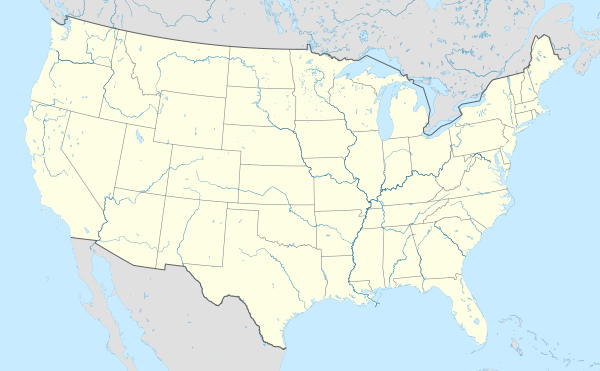 Yellowstone Mesa Verde Grand Canyon Everglades Independence Hall Redwood Mammoth Cave Olympic Cahokia Smoky Mountains Statue of Liberty Yosemite Chaco Monticello UVa Taos Pueblo Carlsbad Waterton-Glacier Robie Taliesin Hollyhock Fallingwater Jacobs Taliesin W. Guggenheim | ||
The United Nations Educational, Scientific and Cultural Organization (UNESCO) World Heritage Sites are places of importance to cultural or natural heritage as described in the UNESCO World Heritage Convention, established in 1972.[1] The United States of America ratified the convention on December 7, 1973,[2] making its historical sites eligible for inclusion on the list.[3]
The first sites in the United States added to the list were Mesa Verde National Park and Yellowstone National Park, both at the Second Session of the World Heritage Committee, held in Washington, D.C., September 5–8, 1978.[4] In total, 24 sites have been included, the most recent being a selection of eight structures exemplifying The 20th-century Architecture of Frank Lloyd Wright in 2019.[5] The twenty-four sites are located in twenty different states and two territories. Arizona, California, Hawaii, Illinois, Montana, New Mexico, New York, and Pennsylvania, each contain multiple sites (with the Frank Lloyd Wright site spread across six states), while two sites (Waterton-Glacier International Peace Park (Montana) and Kluane / Wrangell – St. Elias / Glacier Bay / Tatshenshini-Alsek (Alaska)) are transboundary sites shared with Canada.
Sites[]
- The table lists information about each World Heritage Site:
- Name: as listed by the World Heritage Committee
- Location: city or location of site
- State: one of the 50 U.S. states, the District of Columbia, or the five inhabited territories
- Period: time period of significance, such as construction for buildings; purely natural sites do not have a time period
- UNESCO data: the site's reference number; the year the site was inscribed on the World Heritage List; the criteria it was listed under: criteria i through vi are cultural, while vii through x are natural; (the column sorts by year added to the list)
- Description: brief description of the site
| Name | Image | Location | State | Period | UNESCO data | Description |
|---|---|---|---|---|---|---|
| Mesa Verde National Park | 
|
Montezuma County | Colorado | 6th to 12th centuries | 27; 1978; iii | The site contains a number of cliff dwellings constructed by the ancient Pueblo peoples between the 6th and 12th centuries at an altitude greater than 2,600 metres (8,500 ft). Some notable examples amongst the 600 dwellings include Cliff Palace, Balcony House, and Square Tower House. The dwellings were discovered in 1874.[6] |
| Yellowstone National Park | 
|
Park and Teton counties, Wyoming; Gallatin and Park counties, Montana; Fremont County, Idaho | Wyoming, Montana, Idaho | N/A | 28; 1978; vii, viii, ix, x | The park consists of almost 9,000 square kilometres (9.7×1010 sq ft) of natural forest. The park contains half of the world's geothermal features including over 300 geysers, the world's largest concentration. In addition to its geographical sites, Yellowstone is significant for its natural history; nearly 150 species of fossil plants have been discovered within the park. Set aside in 1872 it bears the distinction of being the first National Park in United States, and the world.[7] |
| Kluane / Wrangell–St. Elias / Glacier Bay / Tatshenshini-Alsek* | 
|
Valdez-Cordova Census Area, Yakutat City and Borough, Southeast Fairbanks Census Area, Hoonah–Angoon Census Area | Alaska (with Yukon and B.C.) | N/A | 72; 1979, 1992 (extended), 1994 (extended); vii, viii, ix, x | The joint United States–Canada site located along the border between the two countries comprise the world's largest non-polar ice field and some of the world's longest glaciers. The region is also the natural habitat for a number of species including grizzly bears, caribou, Dall sheep, and every species of Alaskan salmon, some in greater numbers than found anywhere else.[8] |
| Grand Canyon National Park | 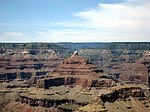
|
Coconino and Mohave counties | Arizona | N/A | 75; 1979; vii, viii, ix, x | The centerpiece of the park is the Grand Canyon, a gorge of the Colorado River. The Grand Canyon is 277 miles (446 km) long, up to 18 miles (29 km) wide and attains a depth of over a mile (6,000 feet or 1,800 metres). Nearly two billion years of the Earth's geological history have been exposed as the Colorado River and its tributaries cut their channels through layer after layer of rock while the Colorado Plateau was uplifted.[9] |
| Everglades National Park |
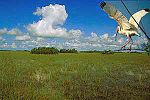
|
Miami-Dade, Monroe, and Collier counties | Florida | N/A | 76; 1979; viii, ix, x | The park is the largest designated tropical wilderness reserve in North America. Featuring a variety of wetlands and tropical hammocks and rainforests, it has become a sanctuary for a large number of birds, reptiles, and threatened or protected species, as well as a host of invasive, introduced, and naturalized species. The property was placed on the List of World Heritage in Danger in 2010 due to degradation of the property resulting in a loss of marine habitat and decline in marine species. The property was previously listed as in danger from 1993–2007 due to sustained hurricane damage and deterioration of water flow and quality due to agricultural and urban development.[10][11] [12] |
| Independence Hall | 
|
Philadelphia | Pennsylvania | 1732-53 (constructed), 1776, 1787. Steeple demolished 1781, replaced with new design 1828. Wings demolished 1812, reconstructed 1898. | 78; 1979; vi | The building was designed by Andrew Hamilton and completed in 1753 to house the colonial assembly of the Province of Pennsylvania. It was the site of the Second Continental Congress during which the Declaration of Independence was signed in 1776. Following the American Revolution, the building held the Constitutional Convention which debated and signed the United States Constitution in 1787. Both documents have served as inspirations for lawmakers and government charters throughout the world.[13][14] |
| Redwood National and State Parks | 
|
Humboldt and Del Norte counties | California | N/A | 134; 1980; vii, ix | Located along the coast of northern California, the park is covered with coast redwood trees, the tallest and one of the most massive tree species on Earth. The park also contains areas of pristine coastline, which support nesting and feeding areas for several species of migratory waterfowl.[15] |
| Mammoth Cave National Park | 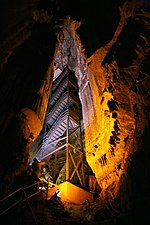
|
Edmonson, Hart, and Barren counties | Kentucky | N/A | 150; 1981; vii, viii, x | Mammoth Cave is the longest cave system known in the world. With over 390 miles (630 km) of passageways, the cave system is home to more than 130 species.[16] |
| Olympic National Park | 
|
Jefferson, Clallam, Mason, and Grays Harbor counties | Washington | N/A | 151; 1981; vii, ix | The park contains a diversity of ecosystems and varied topography ranging from the Pacific coastline, to alpine areas, temperate rainforests, and the forests covering the park's drier east side.[17] |
| Cahokia | 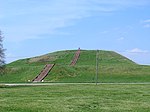
|
St. Clair County | Illinois | 7th to 15th centuries | 198; 1982; iii, iv | The site was the largest and most influential urban settlement in the Mississippian culture which developed advanced societies across much of what is now the Southeastern United States, beginning more than 500 years before European contact. The settlement covered nearly 1,600 hectares (4,000 acres) and included some 120 mounds.[18] |
| Great Smoky Mountains National Park | 
|
Swain and Haywood counties in North Carolina; Sevier, Blount, and Cocke counties in Tennessee | Tennessee, North Carolina | N/A | 259; 1983; vii, viii, ix, x | The park is one of the world's largest remaining remnants of the diverse Arcto-Tertiary Geoflora era, containing over 3,500 plant species and numerous animal species, including one of the world's greatest variety of salamanders.[19] |
| La Fortaleza and San Juan National Historic Site in Puerto Rico | 
|
San Juan | Puerto Rico1 | 15th to 18th centuries | 266; 1983; vi | These structures were built between the 15th and 19th centuries to defend the harbor of San Juan, and are examples of European military architecture adapted to port cities on the American continent. La Fortaleza was the first defensive fortification built for the city. The historic site also comprises Castillo San Felipe del Morro, Castillo de San Cristóbal, El Cañuelo, and three-fourths of the old city wall.[20] |
| Statue of Liberty | 
|
New York City | New York | 1886 | 307; 1984l i, vi | Designed by Frédéric Bartholdi, the statue was a gift to the United States from the people of France. It has since become an icon of freedom and of the United States, and a welcoming signal to immigrants arriving from abroad.[21] |
| Yosemite National Park | 
|
Tuolumne, Mariposa and Madera counties | California | N/A | 308; 1984; vii, viii | Formed as a result of repeated glacial erosion of granitic bedrock over 10 million years, the park contains a unique diverse landscape of spectacular granite cliffs, waterfalls, clear streams, Giant Sequoia groves, and biological diversity.[22] |
| Chaco Culture National Historical Park | 
|
San Juan and McKinley counties | New Mexico | 10th to 12th centuries | 353; 1987; iii | Formerly a major center of culture for the Ancestral Puebloans, the park preserves one of the United States' most important pre-Columbian cultural and historical areas, hosting the densest and most exceptional concentration of pueblos in the American Southwest.[23] |
| Hawaiʻi Volcanoes National Park | 
|
Hawaii County | Hawaii | N/A | 409; 1987; viii | The park is home to Kīlauea and Mauna Loa, two of the most active volcanoes in the world. The volcanic eruptions in the area have resulted in frequently changing landscape, and rare flora and fauna.[24] |
| Monticello and the University of Virginia | 
|
Albemarle County and Charlottesville | Virginia | 18th and 19th centuries | 442; 1987; i, iv, vi | Built between 1769 and 1809, Monticello was the plantation home of its designer, third President of the United States and author of the Declaration of Independence, Thomas Jefferson. Jefferson designed the early buildings that made up the University of Virginia in Charlottesville, inspired by his new ideas of university planning. The most prominent of these, The Rotunda, is a half-scale model of the Pantheon in Rome.[25] |
| Taos Pueblo | 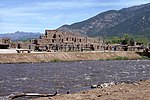
|
Taos | New Mexico | 13th and 14th centuries | 492; 1992; iv | The site is an ancient pueblo belonging to a Native American tribe of Pueblo people, marking the cultural development in the region during the Pre-Columbian era.[26] |
| Carlsbad Caverns National Park | 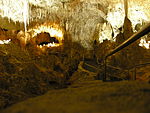
|
Eddy County | New Mexico | N/A | 721; 1995; vii, viii | The park contains over 100 limestone caves, including Carlsbad Caverns and Lechuguilla Cave, which exhibit rare and unique speleothems. This is one of the few sites in the world where scientists can study these ongoing geological and biological processes in its pristine environment.[27] |
| Waterton-Glacier International Peace Park* | 
|
Flathead and Glacier counties | Montana (with Alberta) | N/A | 354; 1995; vii, ix | The joint United States–Canada site located along the border between the two countries has a unique, distinctive climate, physiographic setting, mountain-prairie interface, and tri-ocean hydrographical divide.[28] |
| Papahānaumokuākea | 
|
Honolulu County, Hawaii and Midway Atoll2 | Hawaii and United States Minor Outlying Islands2 | N/A | 1326; 2010; iii, vi, viii, ix, x | The marine national monument encompasses 140,000 square miles (360,000 km2) of ocean waters, including ten islands and atolls of the Northwestern Hawaiian Islands, making it the world's largest marine protected area. The area supports 7,000 species, one quarter of which are endemic. The area is regarded with traditional significance for living Native Hawaiian culture, as an embodiment of the Hawaiian concept of kinship between people and the natural world. The monument also contains the pre-European archaeological sites on the islands of Nihoa and Makumanamana.[29] |
| Monumental Earthworks of Poverty Point | 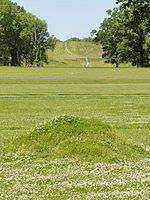
|
West Carroll Parish | Louisiana | 1650 BCE | 1435; 2014; iii | The vast earthen architecture of this site was constructed by a foraging society of hunter- gatherers, not a settled agricultural people, which makes it all the more remarkable a site. It is still not understood how and why such a society could so totally transform this landscape. It may well be the largest hunter-gatherer settlement that has ever existed. Its design was unique and its construction required an unprecedented amount (over 750,000 cubic meters) of earth-moving. Poverty Point was also the center of a major exchange network with goods brought in from as far as 1,600 kilometers (1,000 miles) distant.[30] |
| San Antonio Missions | 
|
San Antonio | Texas | 1700s, 1800s | 1466; 2015; ii | The site encompasses a group of five frontier mission complexes situated along a stretch of the San Antonio River basin in southern Texas, as well as a ranch located 37 kilometres to the south. It includes architectural and archaeological structures, farmlands, residencies, churches and granaries, as well as water distribution systems. The complexes were built by Franciscan missionaries in the 18th century and illustrate the Spanish Crown’s efforts to colonize, evangelize and defend the northern frontier of New Spain. The San Antonio Missions are also an example of the interweaving of Spanish and Coahuiltecan cultures, illustrated by a variety of features, including the decorative elements of churches, which combine Catholic symbols with indigenous designs inspired by nature.[31] |
| The 20th-Century Architecture of Frank Lloyd Wright | 
|
|
Arizona California Illinois New York Pennsylvania Wisconsin |
1900–1950 | 1496; 2019; ii | This listing consists of eight buildings designed by architect Frank Lloyd Wright, "reflecting the 'organic architecture' developed by Wright, which includes an open plan, a blurring of the boundaries between exterior and interior and the unprecedented use of materials such as steel and concrete." Wright's work had international influence.[32][33] |
Sites by state[]
Exclusive sites refer to sites located in a single state or territory. Shared sites refers to sites with entries in multiple states or shared with another country.
| State | Exclusive sites | Shared sites |
|---|---|---|
| New Mexico | 3 | — |
| California | 2 | 1 |
| Arizona | 1 | 1 |
| Hawaii | 1 | 1 |
| Illinois | 1 | 1 |
| New York | 1 | 1 |
| Pennsylvania | 1 | 1 |
| Colorado | 1 | — |
| Florida | 1 | — |
| Kentucky | 1 | — |
| Louisiana | 1 | — |
| Puerto Rico1 | 1 | — |
| Texas | 1 | — |
| Virginia | 1 | — |
| Washington | 1 | — |
| Montana | — | 2 |
| Alaska | — | 1 |
| Idaho | — | 1 |
| North Carolina | — | 1 |
| Tennessee | — | 1 |
| United States Minor Outlying Islands2 | — | 1 |
| Wisconsin | — | 1 |
| Wyoming | — | 1 |
Tentative list[]
The following sites have been added to the United States' tentative list of inclusion on the World Heritage List. The tentative list for sites within the United States was last updated in 2017. In addition to sites within the 50 states, the tentative list includes one site in American Samoa, an unincorporated territory of the United States.[34]
- Big Bend National Park (December 4, 2017)
- Brooklyn Bridge (December 4, 2017)
- California Current Conservation Complex (Greater Farallones, Cordell Bank, and Monterey Bay National Marine Sanctuaries; marine waters and certain coastal areas of Point Reyes National Seashore and Golden Gate National Recreation Area; Farallon Islands National Wildlife Refuge; California Coastal National Monument; and a network of special marine protected areas designated by the State of California) (December 4, 2017)
- Central Park (December 4, 2017)
- Civil rights movement sites (Dexter Avenue King Memorial Baptist Church, Bethel Baptist Church, 16th Street Baptist Church)
- Dayton Aviation sites (Huffman Prairie Flying Field, Wright Cycle Company and Wright & Wright Printing, Wright Hall, Hawthorn Hill)
- Early Chicago Skyscrapers (Auditorium Building, Second Leiter Building, Marquette Building, Rookery Building, Monadnock Building, Old Colony Building, Fisher Building, Schlesinger & Mayer Building, and Ludington Building) (December 4, 2017)
- Ellis Island (December 4, 2017)
- Hopewell Ceremonial Earthworks (Fort Ancient State Memorial, Hopewell Culture National Historic Park, Newark Earthworks State Memorial)
- Marianas Trench Marine National Monument (December 4, 2017)
- Marine Protected Areas of American Samoa (National Marine Sanctuary of American Samoa, Rose Atoll Marine National Monument and Wildlife Refuge) (December 4, 2017)
- Moravian Church Settlements (in the Moravian Bethlehem district of Bethlehem, Pennsylvania) (December 4, 2017)
- Mount Vernon
- Okefenokee National Wildlife Refuge
- Pacific Remote Islands Marine National Monument
- Petrified Forest National Park
- Serpent Mound
- Thomas Jefferson Buildings (Poplar Forest, Virginia State Capitol) — proposed extension of Monticello and the University of Virginia listing
- White Sands National Park
See also[]
- Table of World Heritage Sites by country
- Tourism in the United States
- List of World Heritage Sites in the Americas
Notes[]
- 1. ^ Puerto Rico is an unincorporated territory within the United States.
- 2. ^ Midway Atoll is a part of the United States Minor Outlying Islands, a statistical designation of uninhabited insular areas of the United States and is administered as a National Wildlife Refuge.
References[]
- ^ "The World Heritage Convention". UNESCO. Retrieved September 14, 2012.
- ^ States Parties Ratification Status UNESCO 2014 Retrieved on 03 June 2016
- ^ "United States – Properties inscribed on the World Heritage List". UNESCO. Retrieved September 14, 2012.
- ^ "Report of Rapporteur" (PDF). UNESCO. Retrieved September 14, 2012.
- ^ "The 20th-century Architecture of Frank Lloyd Wright". UNESCO. Retrieved July 8, 2019.
- ^ "Mesa Verde National Park". UNESCO. Retrieved September 11, 2012.
- ^ "Yellowstone National Park". UNESCO. Retrieved September 11, 2012.
- ^ "Kluane/Wrangell-St. Elias/Glacier Bay/Tatshenshini-Alsek". UNESCO. Retrieved September 15, 2012.
- ^ "Grand Canyon National Park". UNESCO. Retrieved November 25, 2012.
- ^ "Everglades National Park". UNESCO. Retrieved November 25, 2012.
- ^ "World Heritage Committee: Seventeenth session" (PDF). UNESCO. pp. 20–21. Retrieved 26 June 2011.
- ^ 34th session 2010, pp. 82–83
- ^ "Independence Hall". UNESCO. Retrieved September 15, 2012.
- ^ "Independence Hall". National Park Service. Retrieved September 15, 2012.
- ^ "Redwood National and State Parks". UNESCO. Retrieved November 25, 2012.
- ^ "Mammoth Cave National Park". UNESCO. Retrieved November 25, 2012.
- ^ "Olympic National Park". UNESCO. Retrieved November 25, 2012.
- ^ "Cahokia". UNESCO. Retrieved November 25, 2012.
- ^ "Great Smoky Mountains National Park". UNESCO. Retrieved November 25, 2012.
- ^ "La Fortaleza and San Juan National Historic Site". UNESCO. Retrieved November 25, 2012.
- ^ "Statue of Liberty". UNESCO. Retrieved November 25, 2012.
- ^ "Yosemite National Park". UNESCO. Retrieved November 25, 2012.
- ^ "Chaco Culture". UNESCO. Retrieved November 25, 2012.
- ^ "Hawaii Volcanoes National Park". UNESCO. Archived from the original on February 24, 2017. Retrieved November 25, 2012.
- ^ "Monticello and the University of Virginia". UNESCO. Retrieved September 11, 2012.
- ^ "Taos Pueblo". UNESCO. Retrieved November 25, 2012.
- ^ "Taos Pueblo". UNESCO. Retrieved November 25, 2012.
- ^ "Waterton-Glacier International Peace Park". UNESCO. Retrieved November 25, 2012.
- ^ "Papahānaumokuākea". UNESCO. Retrieved November 25, 2012.
- ^ "Monumental Earthworks of Poverty Point". UNESCO. Retrieved June 23, 2014.
- ^ "San Antonio Missions". UNESCO. Retrieved July 8, 2015.
- ^ "Two cultural sites added to UNESCO's World Heritage List". UNESCO World Heritage Centre. Retrieved 2019-07-08.
- ^ "UNESCO Adds 8 Frank Lloyd Wright Buildings To Its List Of World Heritage Sites". NPR.org. Retrieved 2019-07-08.
- ^ "Tentative list of United States". UNESCO. March 12, 2017. Retrieved September 11, 2012.
- World Heritage Sites in the United States
- Lists of World Heritage Sites
- Lists of tourist attractions in the United States




